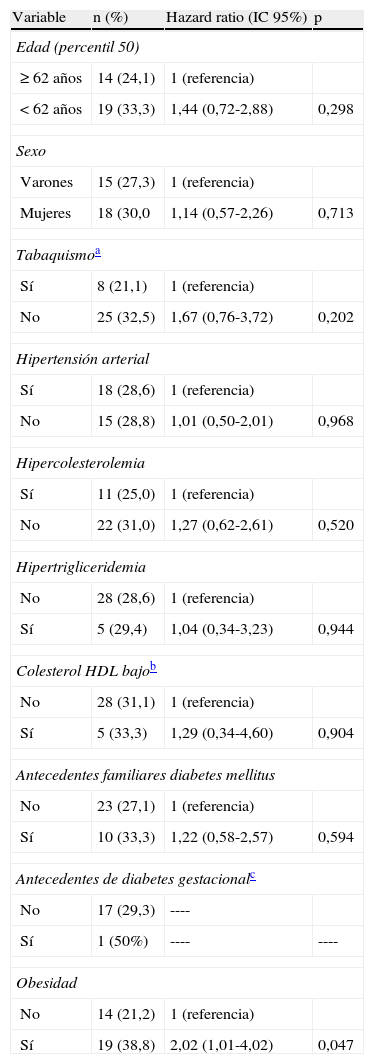El objetivo del estudio fue conocer la incidencia de diabetes mellitus tipo 2 en pacientes con glucemia basal alterada y su asociación con factores de riesgo.
Pacientes y métodoSe incluyeron 115 pacientes > 18 años, seleccionados aleatoriamente en un Centro de Salud, diagnosticados de glucemia basal alterada con los criterios de la Asociación Americana de Diabetes de 1997 y seguidos durante 10 años. Como factores predictivos para desarrollar diabetes mellitus se consideraron: edad, sexo, tabaquismo, hipertensión arterial, hipercolesterolemia, antecedentes familiares de diabetes mellitus tipo 2, antecedente de diabetes gestacional y obesidad.
ResultadosEn 10 años de seguimiento evolucionaron a diabetes mellitus 33 pacientes (28,7%; intervalo de confianza del 95% [IC 95%] 20,4-37,0%), a normoglucemia 57 pacientes (49,6%; IC 95% 40,4-58,7%), permaneciendo como glucemia basal alterada 25 pacientes (21,7%; IC 95% 14,2-29,3%). Solo la obesidad se asoció con la progresión a diabetes mellitus (hazard ratio ajustada 2,01; IC 95% 1,00-4,03, p=0,050).
ConclusionesLa mitad de los pacientes con glucemia basal alterada normalizaron su glucemia y el 28,7% desarrollaron diabetes mellitus, especialmente si tenían obesidad. Estos resultados sugieren una historia natural diferente respecto a la intolerancia a la glucosa.
The aim of this study was to define the incidence of type 2 diabetes mellitus in patients with impaired fasting glucose and its association with risk factors.
Patients and method115 patients aged > 18 years old, randomly selected in a Healthcare Center, diagnosed of impaired fasting glucose with 1997 American Diabetes Association criteria, followed 10 years. Predictive factors for developing diabetes mellitus were: age, sex, smoking, hypertension, hypercholesterolemia, family history of type 2 diabetes mellitus, antecedent of diabetes in pregnancy, and obesity.
ResultsDuring the 10 years of follow-up, 33 patients developed type 2 diabetes mellitus (28.7%; 95% CI 20.4-37.0%), 57 patients progressed to normoglycaemia (49.6%; 95% CI 40.4-58.7%), and 25 patients remained with an impaired fasting glucose (21.7%; 95% CI 14.2-29.3%). Only obesity was associated with progression to type 2 diabetes mellitus (adjusted hazard ratio 2.01; 95% CI 1.00-4.03, p=0.050).
ConclusionsHalf of the patients with impaired fasting glucose normalized their glycaemia, and 28.7% developed diabetes mellitus, especially patients with obesity. These results suggest a different natural history to respect glucose intolerance.
Artículo
Comprando el artículo el PDF del mismo podrá ser descargado
Precio 19,34 €
Comprar ahora








